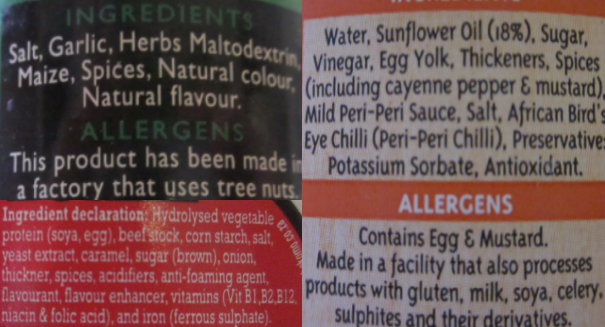Acetylene (\(\text{C}_{2}\text{H}_{2}\)) burns in oxygen according to the following
reaction:
\begin{align*}
2\text{C}_{2}\text{H}_{2}\text{(g)} + 5\text{O}_{2}\text{(g)} \rightarrow
4\text{CO}_{2}\text{(g)} + 2\text{H}_{2}\text{O(g)}
\end{align*}
If \(\text{3,5}\) \(\text{dm$^{3}$}\) of acetylene gas is burnt, what volume of carbon
dioxide will be produced?
\begin{align*}
V_{A} & = \frac{a}{b}V_{B} \\
V_{\text{CO}_{2}} & = \frac{4}{2}(\text{3,5}) \\
& = \text{7}\text{ dm$^{3}$}
\end{align*}
Given the equation:
\[\text{KOH(aq)} + \text{HNO}_{3}\text{(aq)} → \text{KNO}_{3}\text{(aq)} +
\text{H}_{2}\text{O(ℓ)}\]
\(\text{20}\) \(\text{cm$^{3}$}\) of a \(\text{1,3}\) \(\text{mol·dm$^{-3}$}\)
potassium hydroxide (\(\text{KOH}\)) solution was pipetted into a conical flask and
titrated with nitric acid (\(\text{HNO}_{3}\)). It was found that \(\text{17}\)
\(\text{cm$^{3}$}\) of the nitric acid was needed to neutralise the base. Calculate the
concentration of the nitric acid.
Write down all the information you know about the reaction, and make sure that the
equation is balanced.
\(\text{KOH}\): \(V =\text{20}\text{ cm$^{3}$}\); \(c= \text{1,3}\text{
mol·dm$^{-3}$}\)
\(\text{HNO}_{3}\): \(V=\text{17}\text{ cm$^{3}$}\)
The equation is already balanced.
Now we can work out the concentration of the nitric acid:
\begin{align*}
\frac{c_{a}V_{a}}{n_{a}} & = \frac{c_{b}V_{b}}{n_{b}} \\
\frac{c_{\text{HNO}_{3}}(\text{17})}{\text{1}} & =
\frac{(\text{1,3})(\text{20})}{\text{1}} \\
\text{17}c_{\text{HNO}_{3}} & = \text{26} \\
c_{\text{HNO}_{3}} & = \text{1,529}\text{ mol·dm$^{-3}$}
\end{align*}
Note that we don't need to convert the volumes because they are both in
\(\text{cm$^{3}$}\).
Given the equation:
\[3\text{Ca(OH)}_{2}\text{(aq)} + 2\text{H}_{3}\text{PO}_{4}\text{(aq)} →
\text{Ca}_{3}\text{(PO}_{4}\text{)}_{2}\text{(aq)} + 6\text{H}_{2}\text{O(ℓ)}\]
\(\text{10}\) \(\text{cm$^{3}$}\) of a \(\text{0,4}\) \(\text{mol·dm$^{-3}$}\)
calcium hydroxide (\(\text{Ca}(\text{OH})_{2}\)) solution was pipetted into a conical
flask and titrated with phosphoric acid (\(\text{H}_{3}\text{PO}_{4}\)). It was found
that \(\text{11}\) \(\text{cm$^{3}$}\) of the phosphoric acid was needed to neutralise
the base. Calculate the concentration of the phosphoric acid.
Write down all the information you know about the reaction, and make sure that the
equation is balanced.
\(\text{Ca}(\text{OH})_{2}\): \(V =\text{10}\text{ cm$^{3}$}\); \(c= \text{0,4}\text{
mol·dm$^{-3}$}\)
\(\text{H}_{3}\text{PO}_{4}\): \(V=\text{11}\text{ cm$^{3}$}\)
The equation is already balanced.
Now we can work out the concentration of the phosphoric acid:
\begin{align*}
\frac{c_{a}V_{a}}{n_{a}} & = \frac{c_{b}V_{b}}{n_{b}} \\
\frac{(c_{\text{H}_{3}\text{PO}_{4}})(\text{11})}{\text{2}} &=
\frac{(\text{0,4})(\text{10})}{\text{3}} \\
(\text{5,5})c_{\text{H}_{3}\text{PO}_{4}} &=
\text{1,333} \\
c_{\text{H}_{3}\text{PO}_{4}} & = \text{0,24}\text{ mol·dm$^{-3}$}
\end{align*}
Note that we don't need to convert the volumes because they are both in
\(\text{cm$^{3}$}\).
A \(\text{3,7}\) \(\text{g}\) sample of an antacid (which contains mostly calcium
carbonate) is dissolved in water. The final solution has a volume of \(\text{500}\)
\(\text{mL}\). \(\text{25}\) \(\text{mL}\) of this solution is then pipetted into a
conical flask and titrated with hydrochloric acid. It is found that \(\text{20}\)
\(\text{mL}\) of the hydrochloric acid completely neutralises the antacid solution. What
is the concentration of the hydrochloric acid?
The equation for this reaction is:
\[\text{CaCO}_{3}\text{(aq)} + 2\text{HCl(aq)} \rightarrow \text{CaCl}_{2}\text{(aq)} +
\text{H}_{2}\text{O(ℓ)} + \text{CO}_{2}\text{(g)}\]
First convert the volume of the standard solution into \(\text{dm$^{3}$}\):
\begin{align*}
V & = \frac{\text{500}}{\text{1 000}} = \text{0,5}\text{ L}\\
& = \text{0,5}\text{ dm$^{3}$}
\end{align*}
The molar mass of calcium carbonate is:
\begin{align*}
M_{\text{CaCO}_{3}} &= \text{40,1} + \text{12} + \text{16} \times \text{3} \\
&= \text{100,1 mol·dm$^{-3}$}
\end{align*}
Calculate the number of moles of calcium carbonate:
\begin{align*}
n & = \frac{m}{M} \\
& = \frac{\text{3,7}}{\text{100,1}}\\
& = \text{0,03696}\ldots\text{ mol}
\end{align*}
Now we can calculate the concentration of the calcium carbonate standard solution:
\begin{align*}
c & = \frac{n}{V} \\
& = \frac{\text{0,03696}\ldots}{\text{0,5}}\\
& = \text{0,07392}\ldots\text{ mol·dm$^{-3}$}
\end{align*}
Now calculate the concentration of the hydrochloric acid.
Remember that only \(\text{25}\) \(\text{mL}\) or \(\text{0,025}\) \(\text{dm$^{3}$}\) of
the calcium carbonate solution is used.
\begin{align*}
\frac{c_{a}V_{a}}{n_{a}} & = \frac{c_{b}V_{b}}{n_{b}} \\
\frac{(c_{\text{HCl}})(\text{0,02})}{\text{2}} &
\frac{(\text{0,07392}\ldots)(\text{0,025})}{\text{1}} \\
(\text{0,01})c_{\text{HCl}} & = \text{0,001848}\ldots \\
c_{\text{HCl}} & = \text{0,185}\text{ mol·dm$^{-3}$}
\end{align*}

